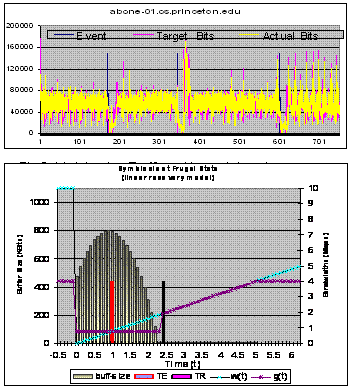

|
During a packet loss event, due to the TCP window squeeze massive surge develops in TCP buffer (the bell ). Conventional application is not aware or this. Once built, all subsequent data entering the buffer is fated to be delayed. Symbiotic congestion control enables applications to actively avoid the surge. The video data generated by a video transcoder in symbiosis with live internet congestion is shown in top. |
|
Symbiotic Congestion Control for Elastic Traffic |
|
Most of the todayís network level schemes for congestion management are based on the principle of temporal disturbance. Schemes depend on variants of packet dropping in network, prioritization (graceful delay in router buffer), admission control (delaying at network egress points), etc. All involve time distortion in the transport pathway. Though such schemes are acceptable time-insensitive traffic but are inherently disturbing for time-sensitive traffic such as multimedia streaming or control data.
Can there be other principles?
It seems an effective delay conformant solution for time-sensitive traffic may be built if the data volume can be reduced by its originator─ the application. This requires however, event driven interaction from the network. If a real-time feedback about congestion is made available to applications then application itself can participate in sophisticated congestion management scheme. We call it the principle of network and application symbiosis.
Network symbiosis is similar in spirit to the TCP-friendly approaches. However, there is a fundamental difference; itís driven by instantaneous network event feedback uniquely enabling it to mitigate temporal disturbance on application data. |
|
ADVANCED NETWORKING: Javed I. Khan and Raid Y. Zaghal, Symbiotic Rate Adaptation for Time Sensitive Elastic Traffic with Interactive Transport, Journal of Computer Networks, Elsevier Science Volume 51, Issue 1, 17 January 2007, Pages 239-257 [DOI] [KhZa06b]
ADVANCED NETWORKING: Javed I. Khan and Olufunke I. Olaleye, Symbiotic Audio Communication on Interactive Transport, Proceedings of the IEEE 21st International Conference on Advanced Information Networking and Applications (AINA-07), Niagara Falls, Canada, May 21-23, 2007, pp.687-694. [IEEECS] [KhOl07]
NET: Javed I. Khan, Raid Zaghal, and Qiong Gu, Dynamic QoS Adaptation for Time Sensitive traffic with Transientware, Proceedings of the 4th International Conference on Wireless and Optical Communication, WOC03, July, 2003, Banff, Canada. [KhZG03a]
NET: Javed I. Khan, Raid Zaghal, and Qiong Gu, Symbiotic Streaming of Time Sensitive Elastic Traffic on an Interactive Transport, The 8th IEEE Symposium on Computers and Communications - ISCC'2003, Antalya, Turkey, June 2003, pp.1435-1440, [KhZG03b]
NETWORK ARCHITECTURE: Javed I. Khan and Raid Y. Zaghal, Interactive Transparent Networking: Protocol Meta-modeling based on EFSM, Journal of Computer Communications, Elsevier Science, Volume 29, Issue 17, 8 November 2006, Pages 3536-3552[ DOI] [KhZa06a] |
|
Selected Publications |
|
More Publications >> |
|
Symbiosis is also distinct and complimentary to classical network-based congestion management approaches; the only responsibility of protocol layers is to pass on selected end-point events to the application. Since, the solutions are implemented at application level; therefore these can be made much more sophisticated without network layer complexity.
To demonstrate the efficacy of the paradigm and the principle, we have designed symbiotic video and audio transcoder systems those work in symbiosis with the network events. These transcoders actively participates in sophisticated domain specific symbiotic back-off scheme in application layer with transport event knowledge resulting and achieve more effective joint quality/delay sensitive communication.
The symbiotic congestion control is applicable for traffic where it is possible to dynamically adjust the data generation rate. We call it time elastic traffic. Most perceptual data, such as audio and video streams generally belongs to this traffic class- control data does not.
We have implemented and tested the real system for various audio and video streaming in worldwide sites and observed dramatic improvement in time-bounded streaming. |

|
Publications Distributions Demo Technical Reports All Projects
|

|
†
|

|
Page last updated February, 2008, Medianet Laboratories. |
|
|
|
Welcome | Projects | Publications | Technical Reports | Software | Resources | Sponsors | Personnel |
